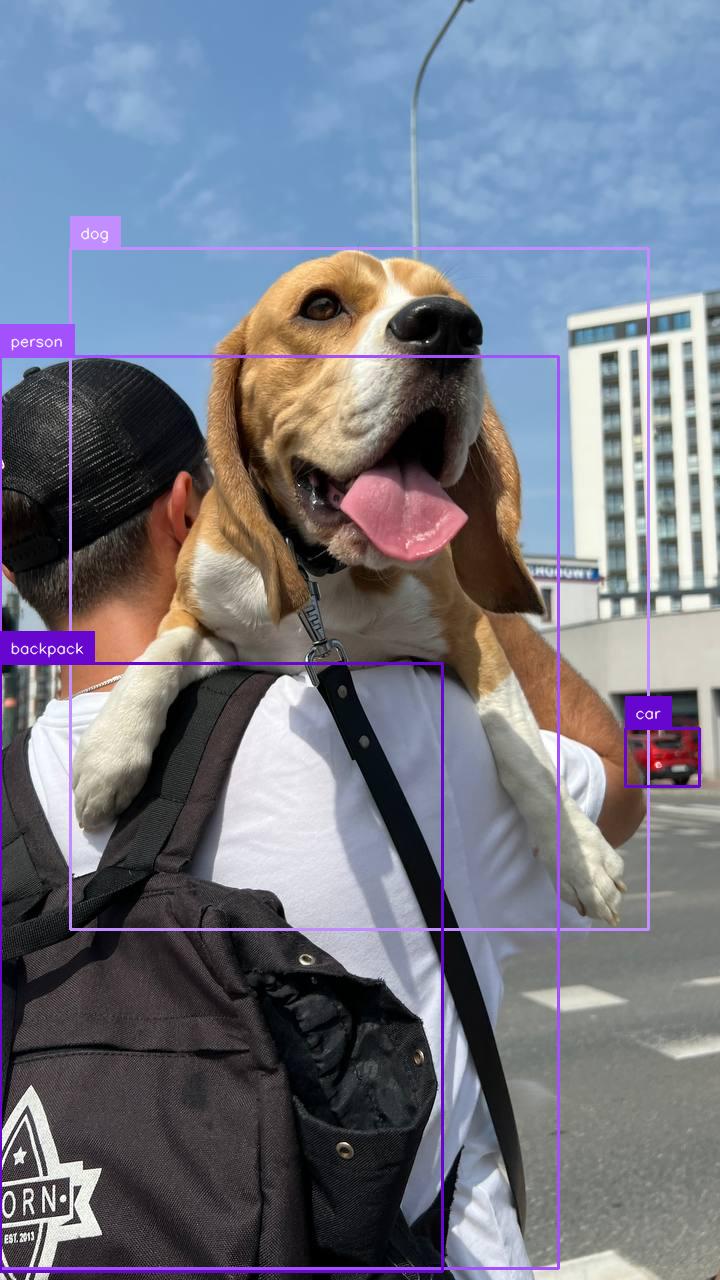Run a Pre-Trained Model
You can run any of the four supported RF-DETR base models -- Nano, Small, Medium, Large -- with Inference, an open source computer vision inference server. The base models are trained on the Microsoft COCO dataset.
To run RF-DETR on an image, use the following code:
import os
import supervision as sv
from inference import get_model
from PIL import Image
from io import BytesIO
import requests
url = "https://media.roboflow.com/dog.jpeg"
image = Image.open(BytesIO(requests.get(url).content))
model = get_model("rfdetr-base")
predictions = model.infer(image, confidence=0.5)[0]
detections = sv.Detections.from_inference(predictions)
labels = [prediction.class_name for prediction in predictions.predictions]
annotated_image = image.copy()
annotated_image = sv.BoxAnnotator(color=sv.ColorPalette.ROBOFLOW).annotate(annotated_image, detections)
annotated_image = sv.LabelAnnotator(color=sv.ColorPalette.ROBOFLOW).annotate(annotated_image, detections, labels)
sv.plot_image(annotated_image)
Above, replace the image URL with any image you want to use with the model.
Here are the results from the code above:

To run RF-DETR on a video file, use the following code:
import supervision as sv
from rfdetr import RFDETRBase
from rfdetr.util.coco_classes import COCO_CLASSES
model = RFDETRBase()
def callback(frame, index):
detections = model.predict(frame[:, :, ::-1], threshold=0.5)
labels = [
f"{COCO_CLASSES[class_id]} {confidence:.2f}"
for class_id, confidence
in zip(detections.class_id, detections.confidence)
]
annotated_frame = frame.copy()
annotated_frame = sv.BoxAnnotator().annotate(annotated_frame, detections)
annotated_frame = sv.LabelAnnotator().annotate(annotated_frame, detections, labels)
return annotated_frame
sv.process_video(
source_path=<SOURCE_VIDEO_PATH>,
target_path=<TARGET_VIDEO_PATH>,
callback=callback
)
Above, set your SOURCE_VIDEO_PATH and TARGET_VIDEO_PATH to the directories of the video you want to process and where you want to save the results from inference, respectively.
To run RF-DETR on a webcam input, use the following code:
import cv2
import supervision as sv
from rfdetr import RFDETRBase
from rfdetr.util.coco_classes import COCO_CLASSES
model = RFDETRBase()
cap = cv2.VideoCapture(0)
while True:
success, frame = cap.read()
if not success:
break
detections = model.predict(frame[:, :, ::-1], threshold=0.5)
labels = [
f"{COCO_CLASSES[class_id]} {confidence:.2f}"
for class_id, confidence
in zip(detections.class_id, detections.confidence)
]
annotated_frame = frame.copy()
annotated_frame = sv.BoxAnnotator().annotate(annotated_frame, detections)
annotated_frame = sv.LabelAnnotator().annotate(annotated_frame, detections, labels)
cv2.imshow("Webcam", annotated_frame)
if cv2.waitKey(1) & 0xFF == ord('q'):
break
cap.release()
cv2.destroyAllWindows()
To run RF-DETR on an RTSP stream, use the following code:
import cv2
import supervision as sv
from rfdetr import RFDETRBase
from rfdetr.util.coco_classes import COCO_CLASSES
model = RFDETRBase()
cap = cv2.VideoCapture(<RTSP_STREAM_URL>)
while True:
success, frame = cap.read()
if not success:
break
detections = model.predict(frame[:, :, ::-1], threshold=0.5)
labels = [
f"{COCO_CLASSES[class_id]} {confidence:.2f}"
for class_id, confidence
in zip(detections.class_id, detections.confidence)
]
annotated_frame = frame.copy()
annotated_frame = sv.BoxAnnotator().annotate(annotated_frame, detections)
annotated_frame = sv.LabelAnnotator().annotate(annotated_frame, detections, labels)
cv2.imshow("RTSP Stream", annotated_frame)
if cv2.waitKey(1) & 0xFF == ord('q'):
break
cap.release()
cv2.destroyAllWindows()
You can change the RF-DETR model that the code snippet above uses. To do so, update rfdetr-base to any of the following values:
rfdetr-nanorfdetr-smallrfdetr-mediumrfdetr-large
Batch Inference¶
You can provide .predict() with either a single image or a list of images. When multiple images are supplied, they are processed together in a single forward pass, resulting in a corresponding list of detections.
import io
import requests
import supervision as sv
from PIL import Image
from rfdetr import RFDETRBase
from rfdetr.util.coco_classes import COCO_CLASSES
model = RFDETRBase()
urls = [
"https://media.roboflow.com/notebooks/examples/dog-2.jpeg",
"https://media.roboflow.com/notebooks/examples/dog-3.jpeg"
]
images = [Image.open(io.BytesIO(requests.get(url).content)) for url in urls]
detections_list = model.predict(images, threshold=0.5)
for image, detections in zip(images, detections_list):
labels = [
f"{COCO_CLASSES[class_id]} {confidence:.2f}"
for class_id, confidence
in zip(detections.class_id, detections.confidence)
]
annotated_image = image.copy()
annotated_image = sv.BoxAnnotator().annotate(annotated_image, detections)
annotated_image = sv.LabelAnnotator().annotate(annotated_image, detections, labels)
sv.plot_image(annotated_image)